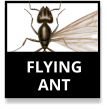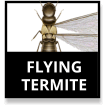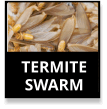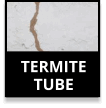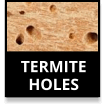TERMITE CONTROL EWING NJ
Eastern subterranean termites cause major headaches for property owners in Ewing. From extensive structural damage to the transmission of disease, these pests are more of a threat than most people realize.
Although there are several hundred termite species that may be encountered around the world, only a handful of these exist in the local region. Still, this subterranean species is particularly well-adapted to cause massive damage to residential and commercial buildings, which puts people at great economic risk.
Termite colonies tend to be enormous, consisting of thousands, or perhaps even millions, of members. The vast majority of these pests are workers whose responsibility it is to forage for food. Working around the clock without stopping, these pests are capable of destroying essential structural portions of buildings both large and small.
People sometimes receive an early warning of the presence of termites when they see suspicious mud tunnels on the foundations of a building. These mud tunnels are imperative to termite survival. Unable to withstand the sun and wind that would cause them irreparable harm, termites construct these mud tubes to protect them as they move from an underground nest to a food source, which may be located in the basement or crawl space of a building.
It is their subterranean lifestyle that enables these large groups of pests to infest a building without people being aware of their presence. Most people do not venture on a regular basis into the places where termites are likely to be found. Accordingly, the pests are free to wreak havoc for months or years without any preventative steps being taken.
If termites are so stealthy, is it even possible for people to protect their property? It absolutely is, but only if regular termite inspections are performed. An examination performed by a professional technician is the best way to spot the early warning signs of termite trouble or to completely head off an infestation.
WHAT DO TERMITES LOOK LIKE?
Termites live in huge colonies that consist of thousands of members. As such, they are social rather than solitary insects. Each colony member has a specific function. Scientists refer to these as castes. Most termites in the colony are workers, but there also are soldiers and reproductives.
Workers regularly move between the nest and the colony's food source. Not frequently seen, the workers are a creamy white color. The body is translucent, although the jaw is a darker color. At about one-eighth of an inch long, these colony members are tiny.
The colony's soldiers may be distinguished from the workers by their dark brown or yellowish coloring as well as their larger size. The heads and jaws are particularly pronounced on these pests. These adaptations are what make the soldiers good at protecting the colony from predators.
The reproductive members of the colony are the largest termites, and they also have two pair of wings that are of equal size. Dark brown or black, reproductives frequently are the harbinger of a much larger infestation. Only mature colonies produce these caste members, and seeing them fly up around the foundation of a building in the spring may be the initial warning to property owners that an infestation has been taking place for some time.
WHERE DO TERMITES LIVE?
Rather than living inside a food source, termites tend to prefer to stay close to the source of their meals. Underground nests are imperative as these pests cannot physically tolerate being exposed to the elements.
Consequently, termite nests are located underground, usually only about four to 18 inches underneath the topsoil. Termites also require certain humidity levels, so they are more likely to construct a nest in moist soil. Nests can be complicated, containing multiple galleries and tunnels.
Food is gathered from a nearby source, which could be a rotting stump, a wooden fence or someone's home. Mud tunnels are constructed between the nest and the food source so that workers can safely move between the two.
HOW TERMITES GET INSIDE
Subterranean termites typically gain entry into homes and businesses where wooden portions of the structure are accessible to them, which include posts, frames, steps, etc.
Additionally, termites can enter through cracks in foundations and stone or brick surfaces as small 1/32 of an inch -- half the thickness of a penny.
Once inside a heated structure, termites can remain active throughout the year and maintain their activities 24 hours a day.
WHAT DO TERMITES EAT?
Subterranean termites specialize in eating cellulose, a material that is found in all plant matter. Cellulose is present in great concentrations in wood, but it also is present in paper products and any ordinary items that may have wood or paper in their basic makeup.
This means that buildings are particularly vulnerable to termite infestation. Examples of items that may be consumed by termites include staircases, subflooring, joists, window sills, window frames and wooden posts.
Termites generally do not exhibit interest in food that is intended for human consumption. However, they may eat the cardboard packaging in which food is contained.
DAMAGE CAUSED BY TERMITES
Ewing property owners have good reason to fear termite infestations. When the pests have been at work for considerable time, the damage they cause can become obvious. A badly compromised floor or ceiling may begin to look swollen. Buckling wood is another clear giveaway that termites are present. People may see a wall or ceiling that looks as if it has sustained damage from a water leak. However, no leak is discovered upon investigation. Instead, termites have been hard at work.
By the time these more obvious signs of an infestation are apparent, the damage is extensive. The termites likely have already hollowed out joists and other wooden components beneath or within the structure. Extensive and immediate repair work is required.
It is critical for property owners to understand that a single termite colony with one million members can consume 15 pounds of wood on a weekly basis. This is why it is crucial for property owners to schedule regular termite inspections to ensure that they are not the victims of massage destruction.
DO TERMITES CARRY DISEASE?
People frequently are surprised to learn that they actually can become ill as a result of a termite infestation. These bothersome pests may be infected with germs, bacteria and toxins that may be responsible for spreading polio, typhus, dysentery and gastroenteritis. Because termites and people make physical contact only on rare occasions, transmission of these illnesses is not common. Still, exposure to termite feces is known to cause or exacerbate respiratory ailments.
HOW TO DETECT TERMITES
Signs of a termite infestation include:
• Dark, flying insects swarm in the spring
• Large piles of shed wings are discarded around foundations
• Various windows or doors start sticking
• Numerous squeaky floorboards are noticed
• Tiles on floors or walls have become loose
• Tapping on wood produces a hollow sound
• Apparent water damage on floors, walls or ceilings
• Paint is peeling off of ceilings or walls
• Drywall is discolored or drooping
HOW TO PREVENT TERMITES
To help prevent termite issues the following steps should be taken:
• Refrain from placing lumber or firewood adjacent to buildings
• Eliminate places on the property where wood and soil are in contact
• Reduce humidity levels in crawlspaces, basements and other places that attract termites
• Find ways to move water away from building foundations
• Have regular inspections performed by a licensed technician
HOW WE TREAT FOR TERMITES
Newtown Termite & Pest Control is a certified Termidor® exterminator. We utilize the nation's #1 termiticide when treating homes or businesses. Our technicians apply the product to the exterior of the structure. Once applied, Termidor® becomes undetectable and begins killing termites by contact and indigestion.
Independent testing conducted by the USDA detected no termite damage in concrete slab structures treated with Termidor® 80 WG for more than 15 years following the treatment.
For effective termite extermination our experienced technicians apply the Termidor along the foundation or exterior of the home or business. Once applied, the termiticide blends into the soil and is transferred to termites as they come in contact with the agent. The termiticide is also transferred among the termite colony as infected termites come in contact with other termites. Termidor kills termites both by ingestion as well as by contact.
Our
termite control treatment service will terminate an existing termite infestation and protect against future occurrences.
OUR TERMITE TREATMENT WARRANTY
Area homes and businesses have been trusting Newtown Termite & Pest Control. since 1993. We are a family owned and managed termite control provider, with an A+ Better Business Bureau rating. Combined, our certified, company-trained technicians have over 50 years of field experience.
Our termite control treatment service will terminate an existing termite infestation and protect against future occurrences.
At Newtown Termite & Pest Control we stand behind our work with our renewable, transferable, triple guarantee:
1: If, within one year of your first treatment, we uncover a new colony of live termites, we will retreat your home for FREE.
2: If, during the first five years of your service contract, we uncover a new colony of live termites, we will retreat your home for FREE.
3: If, during the first five years or any year thereafter, we uncover a new colony of live termites, we'll retreat for FREE ... EVEN IF YOU SELL THE HOME!
WHEN WAS YOUR LAST TERMITE INSPECTION?
Industry experts agree that the first step in effective termite control is to have your home or business undergo a full termite inspection at least every two to three years.
That is because termites, often referred to as the "silent destroyers" can go unnoticed until visible damage occurs.
Having your Ewing area home or business professionally inspected by a certified technician is the best way to help detect the presence of termites and prevent extensive damage.
Schedule a FREE inspection today.
GET THE FACTS
● TERMITE CONTROL ANSWERS
